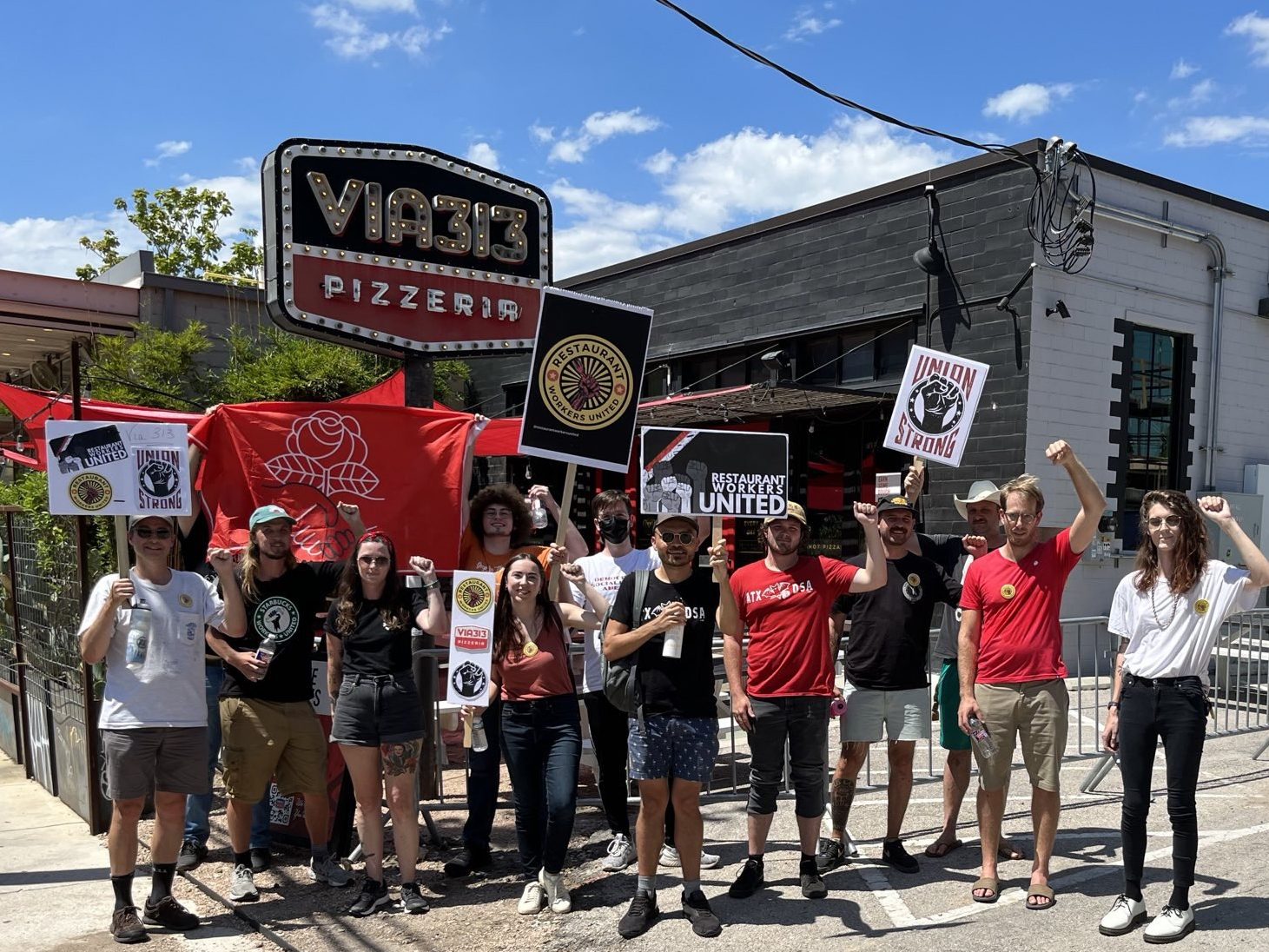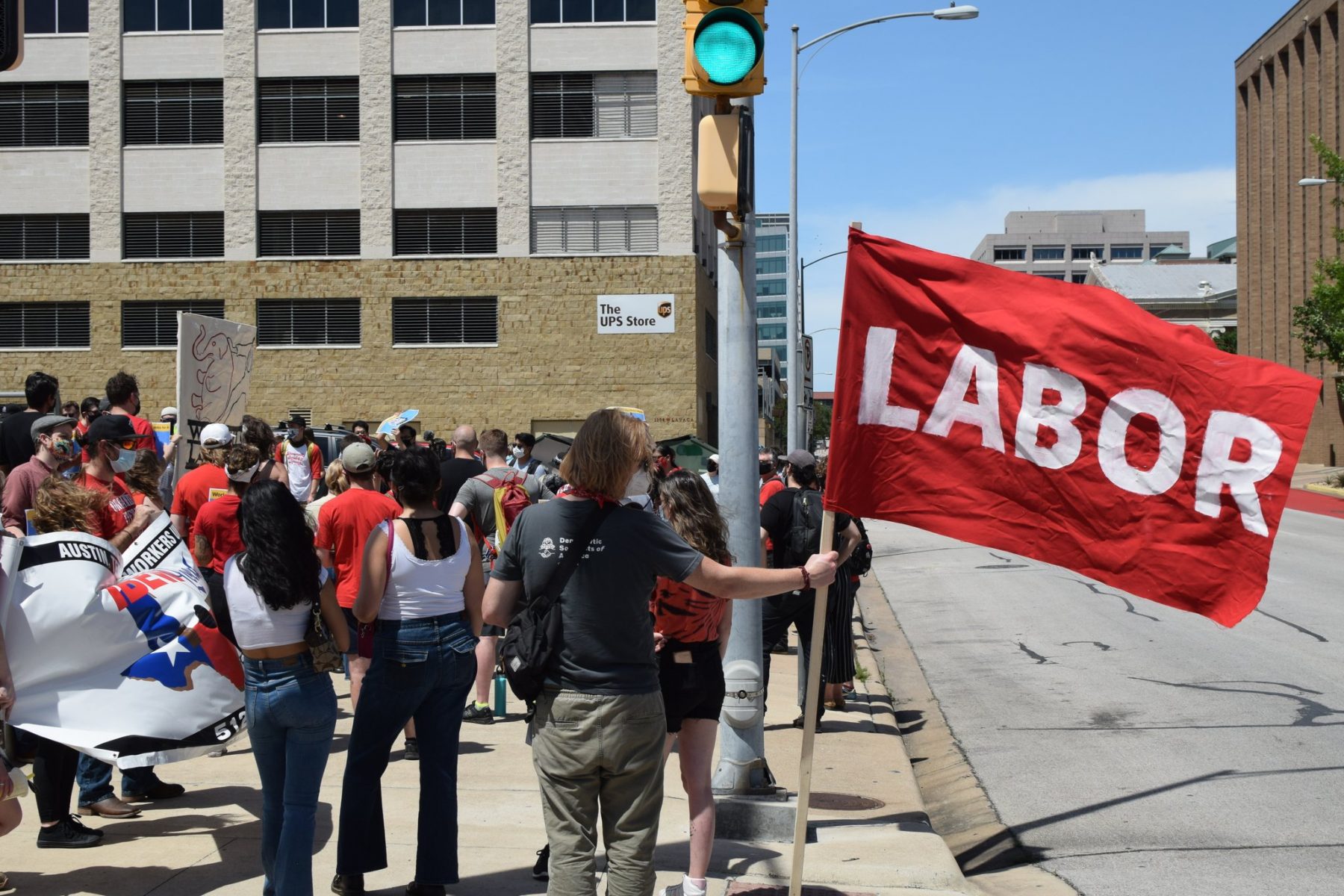After decades of stagnation and decline for the labor movement, workers are striking back. Workers in Austin—baristas, nurses, restaurant workers, and more—are joining this organizing wave. To turn an exciting moment into a movement, we need to overcome employer resistance, organize against the cost of living crisis, and face the challenges of building new organizations.
By Jake J.
Workers across the country are driving a surge in union organizing and strike activity. Unlike other periods of heightened class conflict in recent years such as the educator strike wave of 2017-18, this revolt is not isolated to a single sector but instead encompasses virtually every industry in the US economy. American workers are on the move. The signs are everywhere from front-page news items like the John Deere manufacturing strike, the looming work stoppage on US railways, the rapid organization of almost 250 Starbucks stores, the breakthrough victory at Amazon, and the amazing union victories at REI, Trader Joe’s, and Chipotle.
Austin has been no exception to the national trend toward heightened labor militancy. Just in the past year, Austin workers have organized our city’s first union hotel and first union hospital. Two Austin Starbucks stores have unionized and are preparing to fight for their first contracts, workers at the pizza chain Via 313 are preparing for their union election at three Austin stores, and the stirrings of worker organizing are present throughout the city. The quick progress of the Austin worker movement in the past year is remarkable, but should by no means be taken for granted. Austin employers are a powerful force and to beat them, we will need to think critically about how we got to this point and what directions we need to take moving forward.
Roots of the Revolt
Just because the 2010s were a period of relative “labor peace” does not mean that there was no class conflict, just that it was conducted by the capitalist class against the working class without much organized resistance from the latter. The steady decline of organized labor has been disastrous for poor and working class people. Skyrocketing cost of living, mounting debts and healthcare costs, stagnant wages, and worsening working conditions are just a few of the everpresent symptoms of this uneven arrangement. The massive disruption of the coronavirus pandemic has proven to be the straw that broke the camel’s back. Since 2020, the decades-long trend toward dissatisfaction with present conditions and record-high approval of unions among US workers has finally transformed into action.
The onslaught of one-sided class war has hit Austin workers hard. Since 2019, rents in Travis County have risen 17.4%, now averaging $1,649 according to The Washington Post. This has meant the displacement of long term residents and the pricing out of the people that actually make this city run in favor of wealthy transplants. Austin’s dishwashers, construction workers, hotel housekeepers, teachers, and nurses cannot afford to live where they work and are forced to commute long distances. Even this has become increasingly untenable as gas topped $4 a gallon this summer. On top of rent and gas, food prices have spiked 11.4% since August 2021 according to a recent USDA report and Austin Energy is weighing a 50% rate hike on working-class Austinites. And predictably, wages are not keeping up with the cost of living in Austin.
It is no wonder, then, that workers in Austin are organizing unions. Worker organizing is the clear solution to the cost of living crisis in Austin, because it will not only yield better pay and benefits for hard-pressed workers, but also give them the power they need to address the roots of the present crisis. A powerful working-class movement with the ability to enforce its demands in the workplace can and will become a player in the political sphere which is presently dominated by employers and landlords. Just as business owners rely on the threat of the withdrawal of investment to win political demands, so too does the working class rely on the threat of the withdrawal of labor to do the same thing. Workers empowered by unions gain more control over their lives and win the ability to reshape the city through political organizing. For obvious reasons, this is a frightening prospect for employers.

Roadblocks to Victory
The prospect of a fighting labor movement in Austin directly threatens the ability of the employing class to extract record profits from our labor, so it is only natural that they would oppose it tooth and nail. Employers have met the surge in new organizing with vicious union busting. Starbucks quickly resorted to firing baristas involved in the union effort. Via 313 management has held a series of captive-audience meetings with a highly-paid consultant and gone so far as to escort a pro-union worker out of the building for asking questions in a shameless and desperate attempt to beat the union. We can expect such fierce resistance wherever worker organizing arises and it is on us to figure out how to effectively combat employer disinformation.
Union busting tactics are a serious roadblock as we saw earlier this year when local organizing efforts at Tiff’s Treats were brought to a halt after a concerted campaign by management. Workers at Starbucks and Amazon beat multimillion dollar anti-union campaigns by inoculating their coworkers against company propaganda and continuing to organize on the shop floor in the face of union busting. Victory is possible, even when the odds are stacked against us. It is up to us to make it happen.
Potential Directions
There is no surefire path to victory for Austin workers seeking to organize. Each workplace is different and different approaches are necessary. Ultimately, the workers at any given workplace know what is right for their set of circumstances. Austin nurses and hotel workers have chosen to organize with existing unions because that makes the most sense in their industries. On the other hand, Austin service industry workers have formed their own independent union Restaurant Workers United (RWU) which has set out as its goal the establishment and maintenance of “collective bargaining throughout the restaurant industry”.
While we have to take into consideration workplace differences and be flexible tactically, some principles remain the same regardless of context. To build a strong working-class movement in Austin, we must prioritize worker-to-worker organizing and mass involvement, operate on the basis of union democracy, and maintain a militant approach to organizing and collective bargaining. Following these principles will go a long way in restoring trust in unions and in fostering a self-sustaining movement. It is important to remember that winning a union is just the beginning. After winning a union election, workers have to face management at the bargaining table and mete out a first contract. Above all, the union is a tool for conducting class struggle on the shop floor. This takes place not just during the fight for a union contract but every day. After all, we are exploited by the bosses every day that we work, it only makes sense that this should be opposed by organized workers every day.
On a final note, recent union victories in Austin will only have a broader effect if they are repeated in other workplaces. Organizing your workplace can seem daunting, but there are lots of seasoned labor organizers ready to help you along the way. Ready to start organizing your workplace? Get help from the Emergency Worker Organizing Committee or Restaurant Workers United.
We want to hear from you. Do you have a workplace story or editorial you’d like to share with us? Email us at redfault@austindsa.org!

